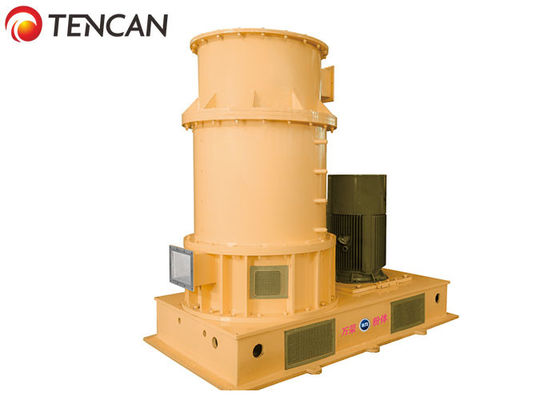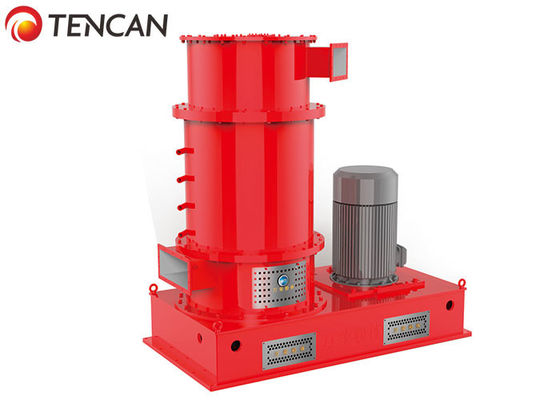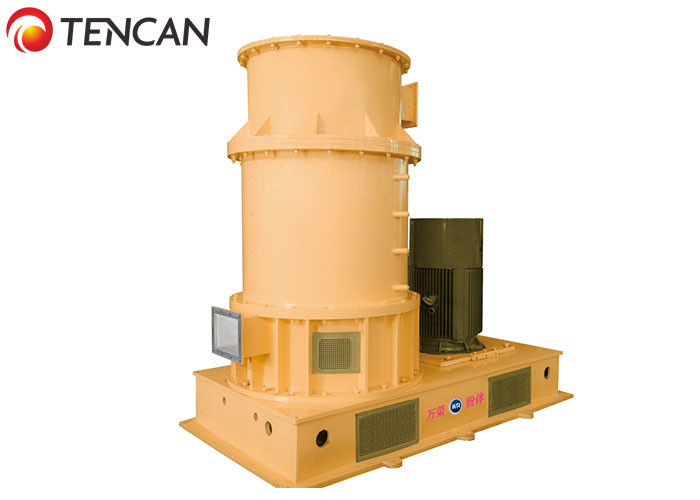China Tencan BCM-350 Limestone, Marble, Calcite Dry Depolymerization Surface Modification Equipment
Product Details:
| Place of Origin: | China |
| Brand Name: | TENCAN |
| Certification: | CE |
| Model Number: | BCM-350 |
Payment & Shipping Terms:
| Minimum Order Quantity: | 1 Unit |
|---|---|
| Packaging Details: | Plywood Case |
| Delivery Time: | Within 1 months of working days after payment |
| Payment Terms: | T/T, L/C |
| Supply Ability: | 50 units per month |
|
Detail Information |
|||
| Product Name: | Beehive Cell Mill | Model: | BCM-350 |
|---|---|---|---|
| Power: | 15KW | Air Flow: | 1250-4000 M3/Hour |
| Speed: | 6500 Rpm | ||
| Highlight: | Dry Depolymerization Surface Modification Equipment,Calcite Surface Modification Equipment,Limestone Cell Mill 6500 Rpm |
||
Product Description
China Tencan BCM-350 Limestone, Marble, Calcite Dry Depolymerization Surface Modification Equipment
1. Beehive Cell Mill-Powder Surface Modification Equipment
Beehive cell mill is a kind of mechanical mill that advocates the practical process of first depolymerization and then drying and simultaneous surface treatment. It is a production-type equipment specifically for grinding of ultra fine powders with strict requirements in particle size distribution.
The equipment is designed to simultaneously realize grinding, drying, sorting, and chemical surface treatment of powders, and at the same time deagglomerate wet-grinding filter cakes and slurries. The minimum processing capacity of this equipment is 0.05 ton/hour, maximum production capacity can reach 15 tons/hour, and the water evaporation capacity: 3 tons/hour.
2. Structure of Multi-rotor Beehive Cell Mill
1. All beehive cell mills adopt modular design, which allows each device to be customized based on the application requirements and different environments while keeping their basic working principles and the same parts unchanged;
2. Optimize performance of the equipment by changing numbers of rotor’s layer and quantity of blades. The integrally installed sorting machine does not affect the structure of the grinding cavity;
3. This modular structure design makes it very easy to replace and maintain vulnerable and consumable parts;
4. Rotor blades can be made of optional materials such as hardened steel, stainless steel, or tungsten carbide steel, and etc for customers to choose;
5. Grinding groove of the equipment can be made of optional materials like steel, high-chromium iron, stainless steel, high-aluminum ceramics, etc., for users to choose.
3. Working Principle of Multi-rotor Beehive Cell Mill
Beehive cell mill is a new type of powder mixing and modifying machine which Integrates three functions of deep drying, depolymerization and dispersion, and compound modification, it has characteristics of compact structure, small volume, easy operation, stable running, low noise, low labor intensity, and etc.
The equipment cavity adopts high-speed rotating blades to interact with the 360-degree low-speed rotating container cavity to continuously generate high-speed vortex in the cavity to drive the powder sample to move, so as to achieve high-efficiency mixing and dispersion of nano- and micro-level powders. At the same time, the powder can effectively improve the surface properties of the particles under the condition of repeated driving of the vortex. For example, by adding suitable solvents and additives, the powder can be coated.
The main component of the beehive cell mill is a vertically installed multi-stage rotor. Each stage of the rotor consists of two supporting discs mounted on the main shaft and 200 blades clamped. According to specific load requirements, one set of beehive cell mill can be equipped with 10 disaggregation wheel components with total of 2000 disaggregation blades. The blades rotate at a speed of 110 m/s, and the grinding groove is equipped with 6 mm wide stiffener-type fixed lining strips, forming 160 turbulent honeycombs between the blades and the lining strips. The pressure, shear strength and friction force generated from the process can quickly grind the material into ultra-fine powder.
4. Beehive Cell Mill-Principle of Deep Drying
The ultra-fine powder and 110 ~ 160 ℃ hot air are delivered into the air flow drying chamber through the material inlet. In the air flow drying chamber, the rotors rotate at high speed to form violent turbulence, so as to achieve an effect of rapid negative pressure flash drying. Within a few seconds, about 0.5% of the residual water of powder can be almost completely evaporated and separated, so that the final water content in the product can reach the deep drying level of 0.05%. The deep drying of powder lays a good foundation for the subsequent compound modification and dispersion treatment.
5. Characteristics of Beehive Cell Mill
Rotor and lining strips can be taken out of the equipment as a whole.
The rotor and lining strips can be repaired outside the equipment, which shortens downtime.
Rotating part adopts drive pin instead of key, which is easy to install.
There are no bolts of blades or lining strips inside the beehive mill.
The rotating parts have to be tested for dynamic balance before installation to ensure the service life of the bearing.
Under normal condition of running, adjustment is not required for the cell mill.
6. Practical Process System of Beehive Cell Mill
The beehive cell mill modification process is an air sweep system, the material enters into the system through the air flow to modify properties of material.The beehive cell mill modification process is a high efficient process system that requires very precise feeding and extremely stable control technology.According to different characteristics of different material, after material is accurately quantified and weighed, and then material enters into the hot air system by operating the frequency converter. After free water on the surface of the material is removed by the hot air, it is fully dispersed and depolymerized to reduced to the original particles or natural crystal particle size inside the honeycomb cell mill. The fully depolymerized and reduced particles are boiling in the air and are winding to combine with the atomized modifier to form a single-layer nano-coating film. when process is completed, the finished products leave the cell mill through the air stream and go to the back-blown bag filter.
7. Drying Function of Beehive Cell Mill
When the process gas is heated by the hot air generator, the honeycomb cell mill will become a high efficient drying machine. The highest temperature that the beehive cell mill can accept is 450°C. The equipment controls the drying degree of the material by controlling the outlet temperature. The outlet temperature of the typical material is generally 85°C.Purpose of drying function is to break the hydrogen bonds on the surface of the nanometer particles, absorb wet bridges and other chemical bonds role, prevent the particles from adhering to each other and lay a foundation for subsequent deaggregation and crushing.The moisture content of the deeply dried powder can reach 5‰ (five thousandths), meanwhile, materials coated with single particle which the modifier is gasified into are more uniform.
8. Depolymerization Function of Beehive Cell Mill
The honeycomb cell mill runs at a linear speed of 160 m/s, which drives a strong air flow, allowing the agglomerated powder particles to stay in the stator with a special groove design. The wind pressure and wind speed form a strong vortex and generate a shear force. Friction force and centrifugal force quickly knead the material into single particles and reduce it to the original particle size or natural crystal particle size, and the material is under boiling state and is brought out of the disaggregation cavity by the rotor.
9. Coating And Surface Modification
Functional powder material usually requires surface treatment to change its functional properties. Most surfactants can be injected into the honeycomb grinding cavity after being measured and weighed at a certain proportion. Generally, two or more coating media can be used at the same time.
10. Applications
| Minerals | Chemicals | Food |
| Clay | Alginate | Animal Proteins |
| Kaolin (Natural & Burning) | Hydrotalcite | Casein |
| Limestone, Marble, Calcite | Iron Oxide | Cocoa Powder |
| Magnesium Hydroxide | Magnesium Hydroxide | Pea |
| PCC & GCe | Pigment | Potato Proteins |
| Phosphate | Methylcellulose | Sugar |
| Precipitated Silica | Silica Gel | Wheat Flour |
| Talcum Powder | Stearic Acid | Wheat Bran |
| Titanium Dioxide | Zeolite | Wheat Starch |
11. Data of Beehive Cell Mill
| Model No. |
Speed (rpm) |
Air Flow (m3/hour) |
Power (KW) |
Sorting Power (KW) |
| BCM-350 | 6500 | 1250-4000 | 15-30 | 3.3 |
| BCM-500 | 4500 | 2000-6000 | 22-55 | 5.5 |
| BCM-750 | 3000 | 3000-12000 | 45-90 | 7.5 |
| BCM-1000 | 2250 | 4000-15000 | 75-132 | 11 |
| BCM-1250 | 1800 | 5000-20000 | 110-200 | 15 |
| BCM-1500 | 1500 | 6000-25000 | 132-260 | 22 |
| BCM-2250 | 1000 | 9000-37500 | 200-400 | 33 |
12. Cases of Process Line
A. Single-stage grinding process
It is a very economical fine grinding process. Such a production line composed of one cell mill can grind products under 2μm ≤ D92 at a time.
![]()
B, Multiple-stage grinding process
Multiple-stage grinding process line consists of 2-3 sets of cell mills which are connected into a production line for grinding ore, where you can add media balls in different diameters, different specifications, and different specific gravity in each stage of the cell mill, you can grind to obtain products with diameter of 2μm≥D98 at a time. The multi-stage grinding process has characteristics of flexible changes, it is easy to produce D60 and D90 products without adding any other equipment, which can be changed from series mode to parallel mode.
![]()
C. Multi-stage mixing process
If you need to grind high-strength and large sized particles, you are suggested to use spiral cell mill for pre-grinding, where large sized particles of materials can be effectively crushed by strong impact and collision of the steel balls based on its gravity grinding technology. The multi-stage mixing process can better show its excellent grinding performance for grinding high-strength particles.
![]()





